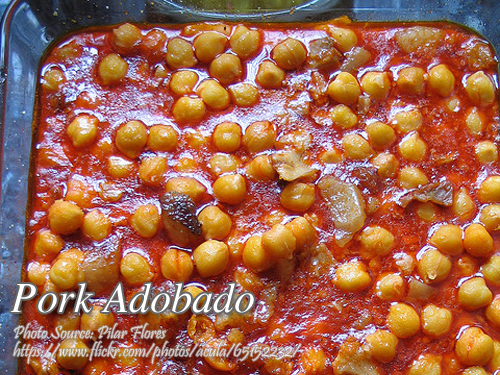Adobado or adovada is a Spanish word meaning “marinated”. There are various ways of cooking adobado and various kinds of marinades but I guess this adobado recipe here is a Pinoy version. This version also reminds me of the dish menudo but most of the time it was not marinated first before cooking. Our method of cooking menudo is marinating the pork with soy sauce, kalamansi juice for 2 hours before cooking which makes it more tasty and flavorful.
Pork Adobado: A Taste of Tradition in Every Bite
There’s something about a home-cooked meal that stirs up memories of family, tradition, and heritage. Growing up, Sundays at our house were never complete without a pot of something simmering on the stove, filling the air with the aroma of garlic, vinegar, and spices. One dish that always stood out was this particular take on adobo—what my grandmother referred to as adobado.
Adobado, a term rooted in the Spanish word for “marinated,” is a beloved staple in many Filipino households. While there are countless variations, our version always leaned more towards the heartier, richer side of things. Though the method may remind you of menudo—with that same savory base—what sets this apart is how the meat soaks up the marinade, making it tender and full of flavor with every bite.
A Family Heirloom in Every Dish
I remember vividly how my aunt would always say that the secret to a great adobado isn’t just in the ingredients; it’s in the time you give to let the flavors develop. In her kitchen, everything moved a little slower—pork would sit in a blend of soy sauce, calamansi, and spices for hours before even touching the heat. This small but thoughtful step allowed the meat to soak in all the flavors, creating a dish that was as rich in taste as it was in tradition.
When I make this dish today, I can’t help but be reminded of her patience. Back then, I was too eager, always wanting to rush through the preparation. Now, I understand the magic that happens when you let the pork marinate long enough to truly absorb the flavors. You’re not just cooking a meal—you’re preserving a tradition, a connection to those who came before you.
The Simplicity Behind Every Serving
One of the most beautiful things about this dish is how uncomplicated it is. It requires only a few staple ingredients you likely already have in your kitchen: pork, soy sauce, calamansi juice, and a handful of aromatics. After combining everything in a pot, the marinade infuses the pork with that familiar balance of salty, sour, and savory.
My uncle, who was always the “chef” of the family, once told me the secret lies in letting the ingredients speak for themselves. He never believed in overcomplicating a recipe. In his words, “Good food is good food, no need to dress it up.” When it came to cooking this dish, he made sure that the pork was tender and the sauce had just the right thickness—enough to coat each piece without overwhelming it. It was these small nuances that made the meal special.
A Dish Born from History
The origins of adobado are steeped in history. The term “adobo” was introduced to the Philippines by Spanish colonizers in the 16th century, but the process of marinating meat in vinegar and spices existed long before that in the archipelago. Native Filipinos were already using vinegar as a preservative—a clever way to keep food from spoiling in the tropical heat. Over time, this cooking method was combined with the Spanish influence, and what we know today as adobado was born.
While different regions have their own take on the dish, what unites all versions is the principle of marinating and simmering meat in a flavorful concoction. Whether it’s made with chicken, beef, or pork, the essence of adobado remains the same: simple ingredients brought together by time and care.
Bringing It All Together
After marinating the pork, it’s time to bring the dish to life. The pot is heated, the mixture brought to a boil, and then the heat is lowered so the meat can simmer gently. It’s during this time that the magic happens—the pork becomes tender, and the liquid begins to thicken into a rich sauce that clings to each bite.
There’s something soothing about the slow simmer of this dish. It reminds me of lazy afternoons spent around the table, the anticipation building as the house filled with the irresistible aroma of garlic and soy sauce. By the time the meal was served, we were all ready for that first bite of perfectly tender meat, dripping with flavor.
A Taste That Stays with You
When you finally sit down to enjoy this meal, you’re not just eating—you’re experiencing a small piece of history. Each forkful of marinated pork carries with it the lessons passed down from generation to generation. It’s more than just sustenance; it’s a connection to the past, a reminder of where we’ve come from.
I still cook this dish the way my aunt and uncle did, sometimes tweaking it slightly but always keeping the heart of the recipe intact. Each time I make it, it brings me back to those moments in the kitchen, learning the importance of patience, tradition, and the simple joys of a well-cooked meal. So, when you’re ready to try your hand at this dish, remember that it’s not just about following a recipe—it’s about carrying forward a legacy.
The next time you’re craving something comforting, give this simple yet flavorful dish a try. You’ll find that while the ingredients are humble, the result is anything but. Serve it hot, with plenty of rice to soak up that savory sauce, and enjoy the flavors of home, history, and tradition in every bite.
How to Cook Pork Adobado
Ingredients
- 1 kilo pork belly liempo, sliced into serving pieces
- 1/4 kilo pork liver cut into cubes
- 2 pcs potatoes peeled and diced
- 2 pcs carrots peeled and diced
- 1/4 cup garbanzos
- 1/4 cup pickle relish
- 1 cup tomato sauce
- 1 head garlic crushed
- 2 pcs red onions chopped
- 1 1/2 Tbsp. white sugar
- 1/4 cup grated cheese
- 1/2 cup water
Instructions
How to cook pork adobado:
- Combine all ingredients in a pot and mix well. Marinate for an hour.
- Heat the pot and bring the mixture into a boil.
- Lower the heat and let it simmer until the pork is tender and the liquid thickens.
- Serve hot.
Notes
Cooking Tips:
Marinate for Maximum Flavor
To get the most flavor out of the pork, marinate it for at least an hour, though overnight is even better. This allows the soy sauce, calamansi, and spices to deeply penetrate the meat, making it more tender and flavorful. The longer the marinating time, the richer and more intense the taste will be.Simmer Low and Slow
Once the pork is marinated and ready to cook, bring it to a boil, then lower the heat and let it simmer. This slow cooking process helps the pork become melt-in-your-mouth tender, while allowing the sauce to thicken and develop layers of flavor. Rushing this step can lead to tougher meat and a watery sauce.Adjust the Sauce Consistency
If you prefer a thicker sauce, let the dish simmer uncovered during the last few minutes of cooking. This allows the liquid to reduce, creating a richer, more concentrated sauce that clings to the pork. For a lighter consistency, keep the pot partially covered to retain more moisture.





